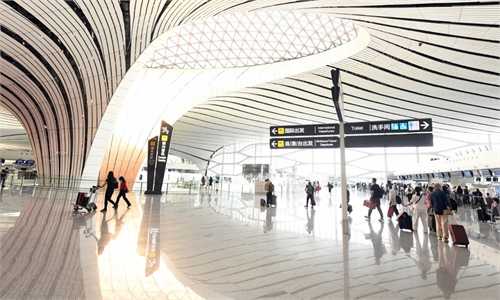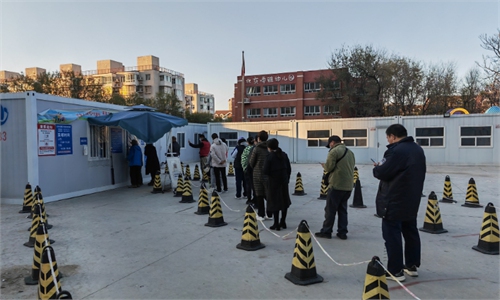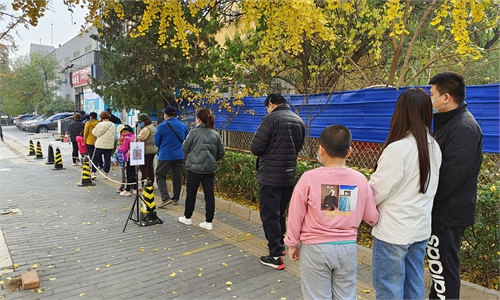China vows to enhance medical resources, crack down on excessive approaches amid severest COVID outbreak in 3 years

People in Shijiazhuang, capital of North China's Hebei Province, buy antipyretics and cold medications in a drugstore on November 15, 2022. These medications have become popular after the city optimized epidemic measures on November 13 in accordance with the country's 20 recently released measures to better respond to COVID-19. Photo: VCG
China has reported a total of 253,000 COVID-19 cases since November 1 during the latest epidemic, and many places in the country are facing the severest and most complicated outbreak in three years, national health officials revealed at a press conference on Tuesday, vowing to enhance medical resources and crack down on excessive anti-epidemic measures adopted by some local governments.
The ongoing epidemic is witnessing growing infections. The average daily new cases this week reached 22,200, nearly double last week's level, Hu Xiang, an official of the national epidemic prevention and control bureau, said at a press conference on Tuesday.
Hu noted that the epidemic, which has hit many provinces and regions, showed complex transmission chains. Some provinces are facing the severest and most complicated epidemic in the past three years.
Densely populated cities like Guangzhou in South China's Guangdong Province and Southwest China's Chongqing Municipality are epicenters of the ongoing outbreaks, as the large population, high personnel mobility and frequent gatherings in key spots like schools increased the risk of epidemic transmission and the difficulty of putting the epidemic under control, according to Hu.
According to the National Health Commission (NHC), China discovered 2,225 confirmed cases and 25,902 silent virus carriers on Monday, making it the seventh day the country reported more than 20,000 cases.
Citing experts who closely follow the situation of China's epidemic, some media outlets predicted on Tuesday that this round of the epidemic would continue to expand until the middle of December. One infected person could spread the virus to five or six other people every four days, experts said, warning of the risk of super-spreader events in some situations.
Experts also warned of the dual threat of COVID-19 and flu this winter and an ensuing medical resources shortage.
Officials at the Tuesday press conference also vowed to enhance medical resources, especially those to treat severe patients in order to further reduce the fatality rate of COVID-19 in China, where the rate of severe cases and deaths from COVID-19 has been kept at a low level.
At the press conference, Hu pointed out that the hidden transmission and the strong transmissibility of Omicron variants make it more difficult to screen and track cases at an early stage. The shortage of hands and resources in high-risk spots like factories, hospitals and schools also increases the difficulty of putting the epidemic under control in a short time.
To prevent excessive measures adopted by some local authorities, considering the severe threat of the rapidly spreading virus, health officials also vowed to strengthen crackdowns on such approaches in order to guarantee full implementation of the 20 measures for optimizing epidemic response.
They will mainly focus on improper moves like unreasonably locking down schools and suspending classes, unreasonably locking down factories to suspend production, suspending traffic without approval, unreasonably suspending medical services and locking down an area for too long.
This round of the epidemic in China is witnessing a growing number of infections related to community transmission. For example, Beijing, the capital of China, discovered and reported 274 confirmed cases and 1,164 asymptomatic cases on Monday with 207 of them discovered in communities. That number was eight on November 1.
Some people asked whether the expansion of community transmission was partly due to the cancellation of tracking secondary close contacts and putting them under quarantine, after the 20 optimized measures were announced earlier this month.
In response, Hu explained at the press conference that the growing community infections were due to the hidden and rapid transmissibility of Omicron, making it more difficult to discover cases if normal epidemic prevention and control management measures were not fully implemented.
Second is the country's faster response to outbreaks, the official said. In the early stage, timely detection of infected persons at the community level, accurate identification of close contacts, and delineation of risk areas are crucial to curbing COVID outbreaks in the first place. Any hesitation would lead to the missing of critical times, which would result in a rapid increase of infections at the community level in the short term and make it more difficult to curb the virus' spread.
Jin Dongyan, a virologist and professor of the School of Biomedical Sciences at the University of Hong Kong, stressed that the 20 optimized measures are intended to guide local authorities to take more scientific and precise steps to combat the epidemic.
Zeng Guang, former chief epidemiologist of China's Centers for Disease Control and Prevention, told the Global Times that the current epidemic in China shows a character of a high infection rate but an extremely low mortality rate, which is different from the early stage of the COVID-19 pandemic. Local authorities in China should adjust their measures according to this character.
But it is not easy for localities to find an ideal way to prevent the epidemic while keeping the impact of anti-epidemic measures on people's daily lives at the lowest level.
After announcing it would suspend compulsory mass nucleic acid testing for about a week, Shijiazhuang in North China's Hebei Province on Monday kicked off a new round of mass testing in all of its six districts for five consecutive days. The move came after 1,067 cases were discovered over the weekend in the city.
How to implement nucleic acid testing in local places is not only an issue of how to optimize usage of resources, but an issue of how to carry out normal nucleic acid testing to reduce the coverage and frequency to be as small and low as possible while guaranteeing effective epidemic prevention and control, health experts said.
If we are going to only focus on high-risk groups as the latest regulations require, is it still necessary to set up testing sites at every district in a city? How should we arrange the locations of the testing sites? These are all issues local authorities need to continue exploring and find answers to, said an anonymous expert, who was quote by China Newsweek as saying on Tuesday.



